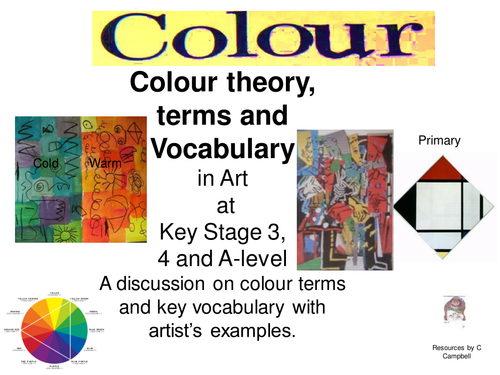

Lesson Objective
A detailed presentation to understand the theory of colour and this 56 SLIDE PRESENTATION gives a complex set of slides on Colour,
Looking at 'What is Colour theory?' AND Colour as light OR COLOUR as pigment and then giving example of sheets to use for a colour wheel.
This then goes into detailed descriptions with examples of TERMS: primary, secondary, intermediary, tertiary but also colour VOCABULARY like HUE, TONAL VALUE, CHROMA, INTENSITY, MONOCHROME, ACHROMATIC, NEUTRAL, DEGRADED colours, COMPLEMENTARY colours, ANALOGOUS colours, TEMPERATURE of colour and LOCAL AND REFLECTED and OPTICAL colour.
It also then looks at where Colour Theory came from - early examples of colour wheel by Goethe and then JOHANNES ITTEN and his colour theories on how colour creates SPACE and goes through how to use colour by contrasting size, texture and value to create this SPACE.
This is for A-level and for Key Stage 3 and 4 to develop an in depth understanding of what is colour. There are tasks to develop in the presentation to develop colour skills.
SOME TASKS: Painting a coloured design to a performance, developing colourful paintings to music, developing tonal values and there are sheets to use for a colour wheel study.
There is also a reference to the PSYCHOLOGICAL meaning of colour
Examples of Colour Theory Terms and artworks that link to the Terms with tasks for students to find different artworks and to analyse and discuss examples of artworks looking at the mood and how colour enhances this.
Use this with A-level students to develop their vocabulary and knowledge of theory of art and how colour interacts. This is a good research study for students to add to their sketchbooks.
A detailed presentation to understand the theory of colour and this 56 SLIDE PRESENTATION gives a complex set of slides on Colour,
Looking at 'What is Colour theory?' AND Colour as light OR COLOUR as pigment and then giving example of sheets to use for a colour wheel.
This then goes into detailed descriptions with examples of TERMS: primary, secondary, intermediary, tertiary but also colour VOCABULARY like HUE, TONAL VALUE, CHROMA, INTENSITY, MONOCHROME, ACHROMATIC, NEUTRAL, DEGRADED colours, COMPLEMENTARY colours, ANALOGOUS colours, TEMPERATURE of colour and LOCAL AND REFLECTED and OPTICAL colour.
It also then looks at where Colour Theory came from - early examples of colour wheel by Goethe and then JOHANNES ITTEN and his colour theories on how colour creates SPACE and goes through how to use colour by contrasting size, texture and value to create this SPACE.
This is for A-level and for Key Stage 3 and 4 to develop an in depth understanding of what is colour. There are tasks to develop in the presentation to develop colour skills.
SOME TASKS: Painting a coloured design to a performance, developing colourful paintings to music, developing tonal values and there are sheets to use for a colour wheel study.
There is also a reference to the PSYCHOLOGICAL meaning of colour
Examples of Colour Theory Terms and artworks that link to the Terms with tasks for students to find different artworks and to analyse and discuss examples of artworks looking at the mood and how colour enhances this.
Use this with A-level students to develop their vocabulary and knowledge of theory of art and how colour interacts. This is a good research study for students to add to their sketchbooks.
Get this resource as part of a bundle and save up to 78%
A bundle is a package of resources grouped together to teach a particular topic, or a series of lessons, in one place.
Something went wrong, please try again later.
This resource hasn't been reviewed yet
To ensure quality for our reviews, only customers who have purchased this resource can review it
Report this resourceto let us know if it violates our terms and conditions.
Our customer service team will review your report and will be in touch.
£6.50